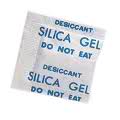 It comes with your new pair of shoes, inside your vitamin bottles, your new bag, and with just about anything new you buy. “It” would be that quaint little packet of “something” that accompanies your newbies, the silica gel pack. If you think the dry and exciting environment of your new buy is something that will not occur in the same thought as rice hull, think again.
It comes with your new pair of shoes, inside your vitamin bottles, your new bag, and with just about anything new you buy. “It” would be that quaint little packet of “something” that accompanies your newbies, the silica gel pack. If you think the dry and exciting environment of your new buy is something that will not occur in the same thought as rice hull, think again.
Utilizing the potentials of an agricultural waste like rice hull as a component in silica gel is the objective of a study conducted by the Natural Science Research Institute(NSRI) and the Bureau of Agricultural Research(BAR).
Rice hull, an abundant agricultural waste, is usually burned in the field contributing to air pollution. With proper methods, however, this agricultural waste can be an effective energy source, and more importantly, can be a source of silica gel.
What is silica gel?
Not to be mistaken for a “silicon gel”, the silica gel is not really a “gel” in form. It is in a porous, granular form of silica. Inside each small silica gel granule is a vast network of inter-connecting microscopic pores, which attract and hold moisture by processes known as physical adsorption and capillary condensation.
To graphically describe how silica gel works, a single teaspoon of hydrosorbent silica gel has an internal adsorptive area equivalent to a football field. Silica gel is inert, non-toxic and safe to use to protect foods, medicines, sensitive materials, electronics, films, etc., from humidity. Even when saturated with adsorbed moisture, silica gel looks and feels dry to the touch. It can also be “reactivated” after it is saturated with moisture so it can be used over and over again.
Most damage to stored valuables, like leather and pharmaceutical products, is caused by humidity trapped in the storage area. Humidity trapped within enclosed space undergoes undetectable condensation, which causes the damage. This damage comes in the form of rust, corrosion, oxidation, mildew, fungus, mold, odor, spoilage, shortened “shelf-life” of photographic film, batteries, and deterioration of foods and medicines.
Silica gel prevents these moisture-related problems, that’s why manufacturers often include a small packet of silica gel in shipments of leather goods and pharmaceuticals. Silica gel creates a protective shield of dry air within any enclosed storage area and it remains the highest adsorbent capacity available today.
Waste not, want not
Scientists at NSRI burned rice hull resulting to high silica (87%) ash. The ash was used to prepare four samples of rice hull silica gel(RHSG). These four samples, a commercial silica gel, and silica gel prepared by the Industrial Technology Development Institute(ITDI) were compared and characterized for chemical and physical structure, drying properties, and elemental impurities. The first sample, RHSG 1, is composed of 21 g rice hull ash (RHA) boiled in 1liter of sodium hydroxide, and was made into gel after 18 hours. RHSG 2 was made up of the same components like the first sample, except that the gel was aged for a week. RHSG 3 was of the same component as the first two samples, except that the resulting gel was soaked in hydrochloric acid overnight. The fourth sample was made of 16 g RHA mixed with 6.7g sodium hydroxide and 65.6 g water.
The study found that rice hull silica gels, RHSG 2 and 4, have properties comparable to the commercial silica gel, and the gel prepared by the ITDI. Depending on the method of preparation, the RHSG has dessicant properties, which can be applied in both high and low humidity environment.
The microstructure of the rice hull silica gel were also observed to have a more uniform particle size and distribution, compared to the commercial and ITDI manufactured silica gel samples. As for the RHSG elemental composition, results show significant lower levels of impurities for the RHSG samples compared to the commercial and ITDI samples.
Rice hull, even as it is regarded as agricultural waste, can be used both as energy source, and as silica gel component. Since the country imports most of the components in manufacturing silica gel, utilizing the potentials of rice hull will also lessen the economic burden brought about by importation.
Sources:
“Silica gels from rice hull: Structure, composition and water vapor adsorption behavior” 2002 by Leni Quirit and Elma Llaguno, Natural Sciences Research Institute (NSRI), Diliman, Quezon City.
www.dehumidity.com/FAQ.html
www.howstuffworks/science/questions206.html
Photo: fesmoving.vn
Article by Ma. Lizbeth J. Baroña – bar.gov.ph, January-March 2004 Volume 6 No. 1
Do you like this money making business ideas for entrepreneurs? then please consider subscribing to our RSS feed and have new business ideas sent directly to your inbox. (Once you entered your e-mail address, you need to login to your e-mail account and click the link to confirm your subscription).




Nice post… It is really informative… Those not can only help but then at the same time protect the society from getting polluted… Very brilliant… Keep it up..